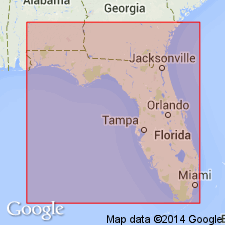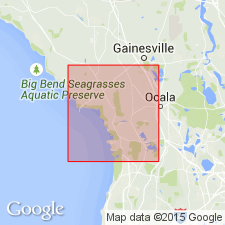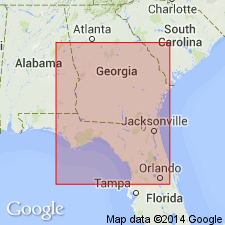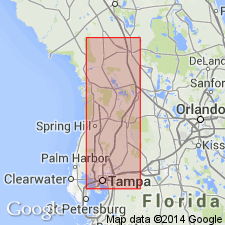
- Usage in publication:
-
- Lawson limestone*
- Modifications:
-
- Named
- Dominant lithology:
-
- Limestone
- AAPG geologic province:
-
- Florida platform
Summary:
New name Lawson limestone applied to limestone facies of late Upper Cretaceous occurring in northeastern FL and the peninsula. Occurs below Cedar Keys limestone and above beds of Taylor age. Divided into two unnamed members: upper--a white and cream-colored calcitic porous limestone containing gypsum in most wells, and lower--a hard white and cream-colored microfossiliferous chalky limestone. Thickness of upper member ranges from 40 ft in Sholtz well No. 2, Levy Co., to 300 ft in Cory well No. 1, Monroe Co. Thickness of lower member is commonly 300 to 400 ft thick, but in Sholtz well No. 2 measures only 75 ft.
Source: GNU records (USGS DDS-6; Reston GNULEX).

- Usage in publication:
-
- Lawson limestone
- Modifications:
-
- Biostratigraphic dating
- Overview
- AAPG geologic province:
-
- Florida platform
Summary:
In recent oil tests, particularly, Humble-Hodges well No. 1 in Taylor Co., FL, fauna characterizing upper member occurs very high in section in interval normally considered Cedar Keys formation of Paleocene age. This indicates that upper Lawson is a transitional bed, including fossils characterizing both Paleocene and Cretaceous. Since characteristic Cretaceous fossils are present, it is considered to represent top of Cretaceous in peninsular FL by most workers.
Source: GNU records (USGS DDS-6; Reston GNULEX).

- Usage in publication:
-
- Lawson Limestone*
- Modifications:
-
- Areal extent
- Age modified
- AAPG geologic province:
-
- Florida platform
- South Georgia sedimentary province
Summary:
Lawson Limestone is assigned a Navarro age and placed at the top of the Gulfian Series in subsurface of northern FL and southeastern GA.
Source: GNU records (USGS DDS-6; Reston GNULEX).

- Usage in publication:
-
- Lawson Formation
- Modifications:
-
- Revised
- Reference
- AAPG geologic province:
-
- Florida platform
Summary:
New type wells [reference sections] are established because original wells are in poor condition. There are no type fauna left and cuttings have been mixed or lost. Top of unit is here moved downward. Interval ranges from 30 ft to 2265 ft. Name is here changed from Lawson Limestone to Lawson Formation as the lithology of the unit is varied. Underlies Cedar Keys Formation (Paleocene) and overlies Pine Key Formation (Late Cretaceous). Age of the Lawson is Late Cretaceous.
Source: GNU records (USGS DDS-6; Reston GNULEX).
For more information, please contact Nancy Stamm, Geologic Names Committee Secretary.
Asterisk (*) indicates published by U.S. Geological Survey authors.
"No current usage" (†) implies that a name has been abandoned or has fallen into disuse. Former usage and, if known, replacement name given in parentheses ( ).
Slash (/) indicates name conflicts with nomenclatural guidelines (CSN, 1933; ACSN, 1961, 1970; NACSN, 1983, 2005, 2021). May be explained within brackets ([ ]).

